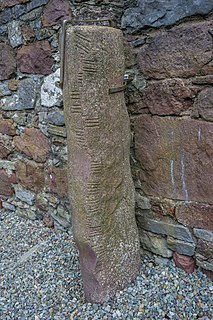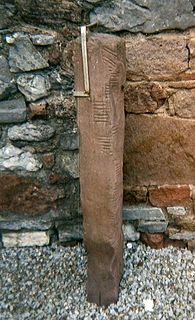
Primitive Irish or Archaic Irish is the oldest known form of the Goidelic languages. It is known only from fragments, mostly personal names, inscribed on stone in the ogham alphabet in Ireland and western Great Britain from around the 4th to the 7th or 8th century.
Beith is the Irish name of the first letter of the Ogham alphabet, ᚁ, meaning "birch". In Old Irish, the letter name was Beithe, which is related to Welsh bedw(en), Breton bezv(enn), and Latin betula. Its Proto-Indo-European root was *gʷet- 'resin, gum'. Its phonetic value is.
Middle Irish is the Goidelic language which was spoken in Ireland, most of Scotland and the Isle of Man from circa 900-1200 AD; it is therefore a contemporary of late Old English and early Middle English. The modern Goidelic languages—Irish, Scottish Gaelic and Manx—are all descendants of Middle Irish.
Luis (ᚂ) is the second letter of the Ogham alphabet, derived either from luise "flame" or from lus "herb". Its Proto-Indo-European root was either *leuk- 'to shine' or *leudh- 'to grow'. Its phonetic value is [l].
The Forfeda are the "additional" letters of the Ogham alphabet, beyond the basic inventory of twenty signs. The most important of these are five forfeda which were arranged in their own aicme or class, and were invented in the Old Irish period, several centuries after the peak of Ogham usage. They appear to have represented sounds felt to be missing from the original alphabet, maybe é(o), ó(i), ú(i), p and ch.
Uath, Old Irish Úath, hÚath, is the sixth letter of the Ogham alphabet, ᚆ, transcribed ⟨ʜ⟩ in manuscript tradition, but unattested in actual inscriptions. The kenning "a meet of hounds is huath" identifies the name as úath "horror, fear", although the Auraicept glosses "white-thorn":

In Lebor Ogaim, also known as the Ogam Tract, is an Old Irish treatise on the ogham alphabet. It is preserved in R.I.A. MS 23 P 12 308–314, T.C.D. H.3.18, 26.1–35.28 and National Library of Ireland MS G53 1–22, and fragments in British Library Add. 4783. It does not bear a title in the manuscripts, but it is mentioned in the Auraicept na n-Éces (2813f.) as amal isber in leapar ogaim, whence the commonly used title. The Ogham Tract is independent of the Auraicept, and is our main source for the Bríatharogaim.
Nion is the Irish name of the fifth letter of the Ogham alphabet, ᚅ, probably meaning "fork". In Old Irish, the letter name was Nin, a name which is notable for referring both to a specific letter, and to any of the Ogham letters in general.
Fearn is the Irish name of the third letter of the Ogham alphabet, ᚃ, meaning "alder-tree". In Old Irish, the letter name was Fern, which is related to Welsh gwern(en). Its Primitive Irish root was *wernā and its phonetic value then was [w]. Its Old Irish and modern phonetic value is [f].
Sail or Saille is the Irish name of the fourth letter of the Ogham alphabet, ᚄ, meaning "willow". The name is related to Welsh helyg(en) and Latin salix. Its Proto-Indo-European root was *sal-. Its phonetic value is [s].
Dair is the Irish name of the seventh letter of the Ogham alphabet, ᚇ, meaning "oak", which is related to Welsh derw(en) and to Breton derv(enn). Its Proto-Indo-European root was *deru- 'oak'. Its phonetic value is [d].
Ailm is the Irish name of the twentieth letter of the Ogham alphabet, ᚐ. Its phonetic value is [a]. The "Tree Alphabet" glossators identify it with the pine. The original meaning of the name is unknown. The Bríatharogam kennings all refer to the sound [a] and not to the name, either as the sound of a "groan", or to the Irish vocative particle, á. Thurneysen maintained that Ailm, Beithe was influenced by Alpha, Beta, but while beithe is an actual Irish word, ailm would have to be considered the only loaned letter name. The word is attested once outside a context of the Ogham alphabet, in the poem "King Henry and the Hermit",
nGéadal is the Irish name of the thirteenth letter of the Ogham alphabet, ᚍ.

A gold bar, also called gold bullion or a gold ingot, is a quantity of refined metallic gold of any shape that is made by a bar producer meeting standard conditions of manufacture, labeling, and record keeping. Larger gold bars that are produced by pouring the molten metal into molds are called ingots. Smaller bars may be manufactured by minting or stamping from appropriately rolled gold sheets. The standard gold bar held as gold reserves by central banks and traded among bullion dealers is the 400-troy-ounce Good Delivery gold bar. The kilobar, which is 1000 grams in mass, is the bar that is more manageable and is used extensively for trading and investment. The premium on these bars when traded is very low over the spot value of the gold, making it ideal for small transfers between banks and traders. Most kilobars are flat, although some investors, particularly in Europe, prefer the brick shape. Asian markets differ in that they prefer gram gold bars as opposed to Troy ounce measurements. Popular sizes in the Asian region include 10 grams, 100 grams and 1,000 gram bars.
Ifínᚘ is one of the forfeda, the "additional" letters of the Ogham alphabet. Its sound value according to the Auraicept na n-Éces, De dúilib feda and In Lebor Ogaim, are io, ía, and ia, respectively. The Auraincept glosses the name according to the "arboreal" tradition as spinan no ispin "gooseberry or thorn". The letter's invention dates to the Old Irish period, several centuries after the peak of Ogham usage. Since the Ogham alphabet dates to the Primitive Irish period, it had no sign for [p] in its original form. Ifín may originally have been added as a letter expressing [p], called Pín. Due to the "schematicism of later Ogamists", who insisted on treating the five primary forfeda as vowels, [p] had again to be expressed as a modification of [b], called Peithe, after Beithe, also called beithe bog "soft beithe" or, tautologically, peithbog, and the earlier letter designed to express p was renamed to i-phín, and considered as expressing an i- diphthong.
Use of the early medieval Irish ogham alphabet is largely divided between "monumental" epigraphy and "scholastic" use in, or influenced by, manuscript tradition,

Bartinney Castle is an Iron Age enclosure located in the Penwith Peninsula of Southwest Cornwall, England, United Kingdom, it is surrounded by a circular earthwork standing on a hill surrounded by various archaeological prehistoric remains, including ancient settlements, field systems, tumuli and cairns.






